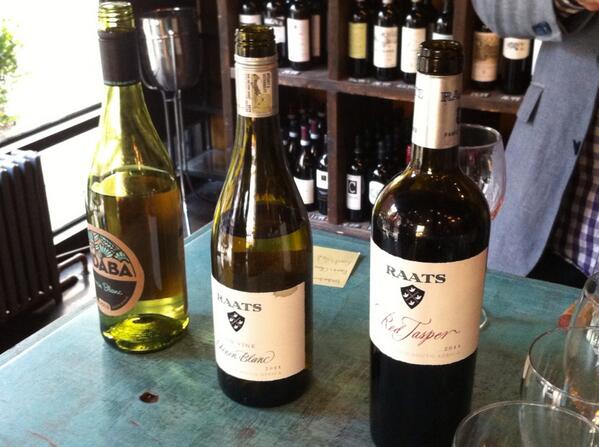One of the most important things in winemaking, at least in new world countries where vintage variation is less of a factor, is consistency. As a writer I would rather be effective across a smaller range of topics than create a broad-ranging array of articles with little focus. To that end I am writing today about a few tastings I've conducted over the past month with a few other South African wines with which I have become well-acquainted in recent years. Keeping up on how wines age and how producers develop from vintage to vintage is very important to me.
Two wineries are in the spotlight here: Raats and De Trafford, both wineries I consider to be at the forefront of top-quality production.
I wrote last year upon my first encounter with Raats Wines (an article that can be found here) and was impressed by both a vineyard management style that can be described as 'harsh' and a range of wines that can be described as 'awesome.' At last I managed to revisit two wines of the Raats lineup and was not disappointed by what I found. The Old Vine Chenin Blanc and the Red Jasper both presented themselves marvellously with all the subtlety and power I remembered from them.
 The Old Vine Chenin is still one of the true greats among South African Chenin. As a varietal that is more and more frequently blended with Viognier and other Rhône varietals at the highest level (to great effect at Sijnn and Keermont), it is comforting to see that Bruwer Raats has put forward a Chenin that exhibits a freshness and linearity that is difficult to rival outside of the Loire Valley and Chablis. Mineral-laced and lively, it shows off the great character of the decomposed dolomitic granite soils that make this regions terroir so exciting. The 2012 vintage is easily as good as the 2011 I tasted last year and could easily age for a few years with excellent results.
The Old Vine Chenin is still one of the true greats among South African Chenin. As a varietal that is more and more frequently blended with Viognier and other Rhône varietals at the highest level (to great effect at Sijnn and Keermont), it is comforting to see that Bruwer Raats has put forward a Chenin that exhibits a freshness and linearity that is difficult to rival outside of the Loire Valley and Chablis. Mineral-laced and lively, it shows off the great character of the decomposed dolomitic granite soils that make this regions terroir so exciting. The 2012 vintage is easily as good as the 2011 I tasted last year and could easily age for a few years with excellent results.The Red Jasper is a beautifully fresh, yet full-bodied example of Cabernet Franc in a leading role. It is a rare thing to see Cab Franc take over the role of Cab Sauv or Merlot and lead a rich Bordeaux blend with such class and poise. The Red Jasper is one of those wines that is effortlessly enjoyable upon release but has the balance and durability to spend a few years in a forgotten cellar before being gleefully rediscovered a decade later. I may just neglect a bottle for a bit myself... if I can help myself!
Another wine I was particularly excited to taste again came about entirely by coincidence. I was lucky enough last year to taste a definitive range of verticals from David Trafford's range. Both his Stellenbosch wines and his Sijnn project (the 2007 of which I recently revisited here) are truly excellent wines, and I was very fortunate to be able to taste pretty much every vintage of every wine as well as several non-vintage blends. I recalled tasting the 2005 Blueprint Shiraz as a surprising highlight of the tasting.
Even more surprising was finding two bottles in a loveless state liquor store in Pennsylvania. I obviously bought them and was overwhelmingly satisfied with my purchase. Showing beautiful earthy aromas, leather and dark chocolate, along with just a whiff of black olive and ferrous minerality. I also know for a fact that the Merlot 2004 has withstood the test of time just as beautifully developing some of the qualities of mature bordeaux, while maintaining a smoky richness that is, for me, classically Stellenbosch.
I will continue to hunt for as many wines from my trip as I can, which may be difficult here in New York, but I will do my best and report my findings as I go along. Til then...
Much Love,
G


